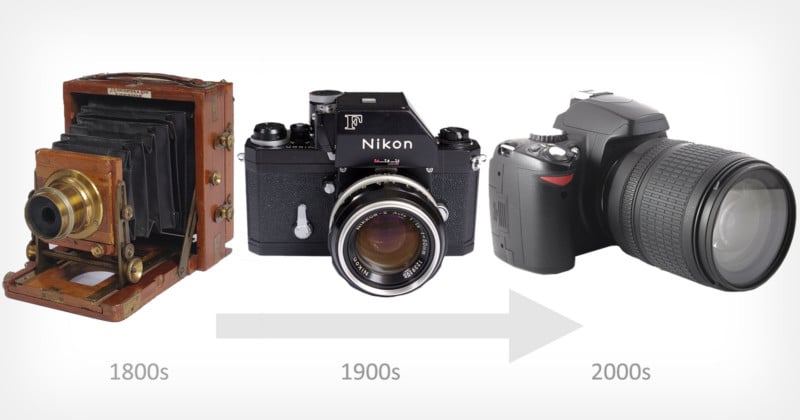Blog
The Evolution of Cameras: From Film to Digital
The Evolution of Cameras: From Film to Digital
Cameras have undergone a remarkable transformation since their invention, reshaping how we capture and preserve moments. From the days of bulky film cameras to today’s sleek digital devices, the journey reflects technological innovation and changing human needs. Let’s explore the evolution of cameras and how they’ve become indispensable tools for storytelling, art, and communication.
Early Beginnings: The Birth of Photography
The concept of capturing images predates modern cameras. The earliest cameras were primitive devices, yet they laid the groundwork for future advancements.
The Camera Obscura
The camera obscura, dating back to ancient times, was the first “camera.” It used a small hole to project an inverted image onto a surface inside a dark room or box. Though it couldn’t record images, it introduced the idea of capturing scenes.
Daguerreotypes and the First Photographs
In 1839, Louis Daguerre introduced the daguerreotype, a revolutionary method that captured images on silver-plated copper sheets. While the process was cumbersome and required long exposure times, it marked the beginning of practical photography.
Film Photography: A New Era
The late 19th century saw significant advancements with the invention of roll film by George Eastman, founder of Kodak. This innovation allowed multiple exposures on a single roll, making photography more accessible to the public.
The Rise of Film Cameras
Film cameras dominated the 20th century, evolving into increasingly sophisticated devices. Their widespread use ushered in the golden age of photography.
The Introduction of 35mm Film
The introduction of 35mm film in the 1920s revolutionized the industry. Compact and versatile, it became the standard format for photography and cinema. Companies like Leica and Nikon produced iconic cameras that used this format.
SLR Cameras: Precision and Flexibility
Single-lens reflex (SLR) cameras gained popularity in the mid-20th century. Their design allowed photographers to see exactly what the lens captured, thanks to a mirror mechanism. These cameras offered interchangeable lenses, enhancing creative possibilities.
Polaroid and Instant Photography
In 1948, Edwin Land introduced the Polaroid camera, enabling instant photography. For the first time, photographers could see their results within minutes, a precursor to the instant gratification of today’s digital images.
The Digital Revolution
The transition from film to digital was a watershed moment in photography. Digital cameras replaced film with electronic sensors, transforming how images were captured, processed, and shared.
Early Digital Cameras
The first digital cameras emerged in the late 20th century. The Kodak DCS 100, released in 1991, was one of the first professional digital cameras. While early models were expensive and bulky, they demonstrated the potential of digital imaging.
DSLR Cameras: Bridging Film and Digital
Digital single-lens reflex (DSLR) cameras gained traction in the early 2000s. Combining the design of SLRs with digital sensors, DSLRs offered photographers the familiarity of traditional cameras with the advantages of digital technology, such as instant image review and adjustable ISO.
Mirrorless Cameras: The New Standard
In the 2010s, mirrorless cameras began to challenge DSLRs. By eliminating the mirror mechanism, these cameras became more compact and lightweight while maintaining professional image quality. Brands like Sony, Fujifilm, and Canon have pushed the boundaries of mirrorless technology.
 Smartphones: Redefining Everyday Photography
Smartphones: Redefining Everyday Photography
The rise of smartphones has dramatically changed how people approach photography. Equipped with advanced cameras, smartphones have made photography more accessible than ever.
Integrated Camera Systems
Modern smartphones feature multi-lens systems with wide-angle, telephoto, and macro capabilities. Computational photography uses software to enhance image quality, allowing even amateur users to take stunning photos.
Convenience and Connectivity
Smartphones combine the convenience of always being in your pocket with the ability to instantly share photos on social media. Apps provide editing tools, filters, and cloud storage, making the entire process seamless.
The Decline of Point-and-Shoot Cameras
As smartphone cameras improve, traditional point-and-shoot cameras have become less common. However, they still find a niche among travelers and casual photographers who want better quality than smartphones offer.
Photography in the Digital Age
The digital era has revolutionized every aspect of photography, from how images are captured to how they’re edited and distributed.
Editing and Post-Processing
Digital images can be edited extensively using software like Adobe Photoshop or Lightroom. Photographers can adjust colors, remove imperfections, and create composites, pushing the boundaries of creativity.
Storage and Sharing
Cloud storage and social media platforms have redefined how photos are stored and shared. Platforms like Instagram, Flickr, and Pinterest serve as digital galleries for photographers of all levels.
AI and Automation
Artificial intelligence (AI) is playing a growing role in photography. From auto-focus and scene detection to AI-enhanced editing tools, technology is making photography more accessible and efficient.
The Future of Cameras
The evolution of cameras is far from over. Emerging technologies promise to reshape photography in exciting ways.
Advancements in Sensors
Larger and more sensitive sensors will continue to improve image quality, especially in low-light conditions. Innovations like stacked sensors and global shutters are already making waves in the industry.
Integration with Augmented Reality
Cameras integrated with augmented reality (AR) are on the horizon. These could enable immersive experiences and new creative possibilities for photographers and videographers.
Sustainability and Eco-Friendly Designs
As environmental concerns grow, camera manufacturers are exploring sustainable materials and energy-efficient designs to reduce their carbon footprint.
 Conclusion
Conclusion
From the camera obscura to advanced digital systems, cameras have come a long way. Each innovation has brought photography closer to the masses, making it a vital tool for self-expression, documentation, and art. As technology continues to evolve, the future of cameras holds endless possibilities, ensuring that the magic of photography will continue to inspire generations to come.


